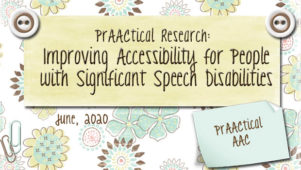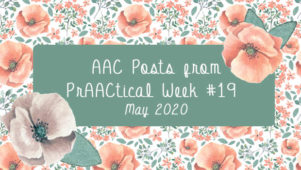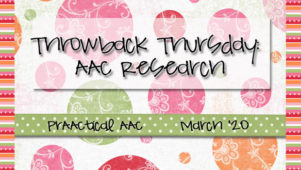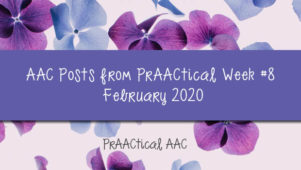PrAACtical Research: AAC Intervention for Children with ASD
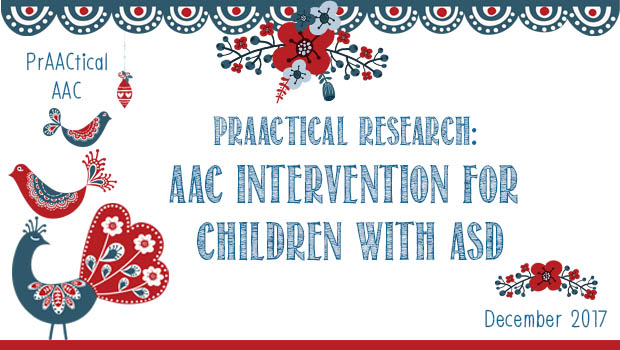
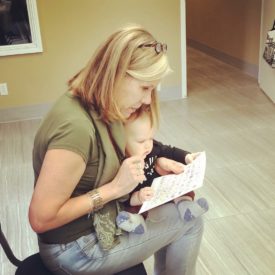 Dr. Kathy Howery is back with another helpful post an AAC research. Kathy is based in Alberta, Canada, and has worked in the field of AT and special education for over three decades. In the past year, she completed her doctoral studies where she used phenomenological methods to seek to understand the lived experience of speaking with/through a speech generating device. Kathy is currently working as a consultant to schools and school districts across Alberta focusing primarily on children and youth with complex communication needs.
Dr. Kathy Howery is back with another helpful post an AAC research. Kathy is based in Alberta, Canada, and has worked in the field of AT and special education for over three decades. In the past year, she completed her doctoral studies where she used phenomenological methods to seek to understand the lived experience of speaking with/through a speech generating device. Kathy is currently working as a consultant to schools and school districts across Alberta focusing primarily on children and youth with complex communication needs.
In this article, she discusses research on AAC interventions.
Enjoy!
:::::::::::::::::::::::::::::::::::::::::::::::::::::::::::::::::::::::::::::::::::::::::::::
Almirall, D. , DiStefano, C., Chang, Y.-C., Shire, S., Kaiser, A., Lu X, Nahum-Shani, I., Landa, R., Mathy, P. & Kasari, C. (2016). Longitudinal Effects of Adaptive Interventions with a Speech-Generating Device in Minimally Verbal Children with ASD. Journal of Clinical Child & Adolescent Psychology, 45(4), 442-456.
What this article is all about (the focus of the research):
The authors introduce their paper with the concerning acknowledgment that the 25%-30% of school-aged children with ASD who do not make significant progress in spoken communication, despite sometimes lengthy access to traditional interventions, have often been overlooked or perhaps of more concern excluded from research studies that aim to develop or evaluate interventions.
They note that the studies that have been done with this population most often focused on teaching requesting or responding, with ‘few addressing interventions focused on language used for broader, socially communicative purposes’ (p.443). Happily, the focus of this research addresses interventions that focus on broader purposes than merely requesting or responding and on both linguistic and nonlinguistic communicative behaviors.
Almirall et al (2016) present a secondary analysis of the research of Kasari et al (2014). The primary study had two main focuses: 1) on the use of adaptive inteventions, and 2) on the impact of the addition of a speech generating device (SGD) to “2 communication-focused and evidence-based early interventions for preschool children – JASPER (Joint Attention Symbolic Play Engagement and Regulation) and EMT (Enhanced Milieu Training)” (Kasari, et al, 2014, p. 636). The results of the Kasari et al (2014) study indicated that participants who began an adaptive intervention with [JASP+EMT +SGD] (vs. those who began adaptive interventions with [JASP+EMT]) had significant improvements in total number of spontaneous communicative utterances, as well as in total novel words and comments (Almirall et al,2016, p. 444).
Almirall et al 2016) extend this research in two ways: 1) through new methods of data analysis that allows exploration of longitudinal outcomes across the three adaptive interventions and 2) by comparing the adaptive interventions in terms of growth in both verbal outcomes (i.e. spontaneous communicative utterances and different root words used) and nonlinguistic outcomes (i.e. initiating joint attention, initiating behaviour regulation, and unique play actions).
As the intended effects of [JASP + EMT] would be to increases in joint attention and play, and that ‘initiating behaviour is expected to improve in concert with initiating joint attention’ (p. 445), this analysis was intended to ‘shed light on the role of SGDs in amplifying the intended effects of JASP+EMT’(p.445).
What their study entailed:
As previously noted, Almirall et al (2016) presents the results of a secondary data analysis. The data was obtained from 61 minimally verbal children ages 5 to 8 with ASD who participated in a previous study undertaken by Kasari, et. al (2014). The Kasari et al. (2014) study tested the effect of adding a speech-generating device (SGD) to naturalistic, developmental and adaptive interventions. The naturalistic, developmental intervention involved joint attention, symbolic play, engagement, and regulation (JASP) blended with enhanced milieu training (EMT).
As this research focuses primarily on the valued added to evidence based naturalistic communication focused interventions by the addition of an SGD it is important to understand what the [JASP + EMT+ SGD] intervention entailed. The following is the description of this intervention from Almirall et al:
The device used was an iPad with an AAC app or a dedicated communication device (e.g. DynaVox or DynaVox Maestro) programmed with picture symbols representing activity- relevant vocabulary. The device was always available during [JASP+EMT] sessions for these children. Devices were not provided for use at home. For the child to learn to use the device, during the [JASP + EMT] sessions, the therapist was required to model language using the device a minimum of 50% of the time. Children were not required to use the device. However, even if the child did not use the device to initiate communication, the therapist was required to expand on the child’s spoken or gestural communication using the device at least 80% of the time (p. 447).
‘The children were assigned to one of three adaptive interventions which differed primarily with respect to the provision of a SGD in the context of [JASP+EMT]’ (Almirall et al, 2016,p.444). As explained in Kasari et al (2014) ‘in an adaptive intervention, treatment may be adapted (e.g. by intensifying the dosage or augmenting the spoken intervention with SGD) to address the specific needs of the child (e.g. if the child is making slow progress in spoken communication) (p.636). Another way to describe the adaptive intervention may be to say the course of the intervention was responsive to the child. Children who responded well to the original intervention either [JASP + EMT] or [JASP +EMT + SGD] continued on that path. For slow responders the intensity of the treatment was increased or in the case of the [JASP + EMT] group, slow responders were divided into either higher intensity with [JASP + EMT] or [JASP +EMT+ SGD]. The primary study focused on increasing spontaneous communicative, spoken language in the children. Their 3 findings were: beginning intervention with the SGD integrated into the blended intervention was superior in producing more spontaneous communicative utterances (NOTE: these were spoken utterances not speech generating device utterances), interventions such as these can lead to minimally verbal children’s spontaneous communication beyond requesting, and ‘adding the SGD later for slow responders to the [JASP+ EMT] alone did not provide the same benefit as from the beginning of the treatment’ (Kasari et al, 2014, p. 645).
The Almirall et al study looked at research outcomes collected at baseline, 12 weeks, 24 weeks and 36 weeks that had been collected during the primary study. They looked at five longitudinal outcome measures. Two verbal outcomes taken from naturalistic language sample (NLS) data were the total number of spontaneous communicative utterances (TSCU) and the number of different word roots (NDWR). The three nonlinguistic outcomes were total initiating joint attention (IJT) and total initiating behaviour regulation (IBR) taken from the Early Social Communication Scales (ESCS) and total number of unique play actions (UPA) taken from the Structured Play Assessment. ‘For all outcomes, a larger value was regarded as better’ (p.446).
Using longitudinal regression models were used to examine between group differences in change in outcomes from baseline through Weeks 12, 24, and 36 (p. 448).
What the authors learned from their study:
To facilitate the comparison of each adaptive intervention, the authors used a derived value, AUC, which has ‘the interpretation as the average of the outcome over the course of the study’ (p. 448). The greater the AUC the better the effect of the intervention.
A very brief description of their results is as follows:
- There were statistically significant differences in the outcomes for TSCU (total number of spontaneous communicative utterances) and for (IJA) initiation of joint attention. That is these two areas showed the most positive results in the research.
- For each of these outcomes (TSCU and IJA), [SGD, SGD] was the adaptive intervention with the largest estimated AUC, [no SGD, SGD] had the second-largest estimated AUC, [no SGD, no SGD] had the smallest estimated AUC value (p. 449). Indicating that provision of SGDs had significant positive impacts on outcomes.
- Providing an SGD during stage 1 produced the greatest chance in both TSCU and IJA.
- For TSCU the introduction of an SGD at stage 2 [no SGD, SGD] seemed to make little difference from the [no SGD, no SGD] intervention. Indicating that providing the SGD from the beginning was what made the difference in the children’s increased spontaneous communicative utterances.
- The trends were somewhat different the social outcome IJA. Introducing the SGD initially had the greatest effect and introducing the SGD at stage two had a greater impact than intensifying [JASP+EMT]. Therefore it seems that adding the SGD at the beginning and at a later stage both made a difference in children’s ability to initiate joint attention.
- There was no evidence of between-group differences in novel words (NDWR) or in initiating behavioural regulation (IBR), although there was evidence of Stage 1 improvement for both outcomes.
- Finally, for the outcomes of unique play actions (UPA) there was not evidence of difference either between groups nor within-groups. This outcome did not change.
Overall, ‘among the three adaptive interventions that were compared, the [SGD, SGD] adaptive intervention was found to be superior’ (p.452).
The primary study (Kasari et al, 2014) demonstrated the promise of adding an SGD to communication focused, evidence-based early interventions for minimally verbal school-aged children with ASD, and that including an SGD from the beginning treatment has the most effect. The Almirall et al (2016) extended these finding to suggest that ‘using an SGD within an effective naturalistic developmental behavioural intervention may facilitate longer and more frequent reciprocal communication interactions, leading to gains in verbal and nonlinguistic communication skills (p. 452, emphasis added).
In their discussion of their results, the authors make note of a couple additional finding. Firstly, that in the intervention sessions that involved [SGD, SGD] the children demonstrated greater increases in the amount of time they spent engaged in reciprocal communication with the therapist (p. 452). They suggest that presence of an SGD within an effective naturalistic behavioural intervention may facilitate longer and more frequent reciprocal communication interactions (p.452), which in turn may account for the gains seen in verbal and nonlinguistic behaviour.
The authors also point to the interesting fact that in this research the therapists did not provide direct instruction to the child to use the SGD and the child was never required to use the SGD (p. 452). They note that providing the SGD did NOT lead to children using them to communicate – the gains in communication were increases in verbal communication by the children. In fact in the Kasari et al paper, it is stated that ‘on average, 92.1% of the total TSCU (across all time points) in the [JASP+EMT+SGD] group were spoken utterances (Kasari, et al, 2014, p. 643, emphasis added).
Almirall et al suggest these may mean that communication gains in the [SGD, SGD] adaptive intervention relative to the others may be due to the therapist modeling use, with or without the child SGD use (p. 453, emphasis added).
The authors also note that when looking at the IJA outcome, that the children who received [no SGD, SGD] adaptive intervention seem to catch up with those who were provided with an SGD from the beginning, the [SGD, SGD] group. This is interesting in that despite the fact that the [SGD, SGD] group had access to the SGD for 24 weeks and the [no SGD, SGD] group only had access to the SGD for the second 12 weeks by week 36 IJA outcomes were similar for both groups by week 36.
The authors suggest it is not surprising, given the nature of the JASP+ EMT intervention did not produce a significant growth in IBR as JASPER places a heavier focus on social commenting (IJA) over requesting (IBR) (p. 453).
In discussing the lack of difference in group with regard to novel word use, the authors suggest that strategic introduction of new play materials along with expanded SGD symbol displays may help extend the novelty of the intervention context and SGD, as well as introduce new vocabulary (p. 453, emphasis added).
The transcription and coding systems used in this research ‘allowed for clear differentiation of children’s communicative function including communication to request and more challenging communication to share (joint attention, commenting)’ (p.453). The authors suggest this uniquely highlights the fact that minimally verbal children can make gains in social sharing as well as the outcome more commonly found in the literature of requesting skills.
Why is this article important for practice?
- Because it focuses on minimally verbal children with ASD that, as the authors point out, are often NOT the focus of research. AND, looks at communication behaviours beyond that of requesting.
- Because it looks at the introduction of an SGD in the context of naturalistic evidence-based practices. While professionals working in the field of autism and AAC may well be aware of the JASPER and EMT interventions, this research challenges us to consider the possible positive additive effects that combine interventions may have on the communication growth of children have not previously responded to interventions.
- Because it uses, and demonstrates, the efficacy of dynamic treatment Dynamic assessment and response to intervention is something oft spoken of in the special education literature. This research, both the Kasari et al (2014) study and the Almiral et al (2016) study point to the value of understanding who are the children who are slower to respond to an intervention and then differentiating the course of intervention.
- This research demonstrates the value of providing SGDs, and providing them early in intervention, for children with ASD and complex communication needs. Based on this research question about when to introduce an SGD to a minimally verbal child with autism may have been answered, and the answer seems to be – as soon as possible!
- This research underscores the power of modeling (Using AAC will delay speech development.
- aided language stimulation). Therapists in this research modeled language using the SGDs and expanded on communicative behaviours of the children on the devices. There was no expectation or demand that the children use the device expressively. As suggested by the researchers the modeling itself could explain the gains made by children in the [SGD,SGD] adaptive intervention. This kind of evidence of the value of modeling is clearly of value to the field.
- Finally, this research provides more evidence to dispel the myth that using AAC will delay the development of speech in children with complex communication needs, or at least in those who have a diagnosis of autism. When provided with modeling of language on an SGD this research showed that the children’s spoken language increased significantly. This is an important finding to share with professionals who may be reticent to bring SGDs into their interventions and to parents of children with ASD who may worry about the use of SGDs because, as I so often hear in the field, they want their child to talk.
What I wonder about…
While I believe this research is important and compelling, there are a couple if things that I wonder about.
- It seems based on the description of how SGDs were used in adaptive interventions that the therapists had set up activity/topic based displays on the devices as opposed to modeling language on a more robust system that is strong on core vocabulary. As best practice in the field of AAC today has moved away from activity based boards/displays in favour of systems that have core vocabulary that can be used flexibly across topics and context and that have well-organized fringe vocabulary, I wonder how the provision of SGDs with this type of vocabulary might have altered the results. I particularly wonder if modeling on an SGD that had a more extensive robust, well-organized vocabulary may have resulted in greater gains in the area of increased novel word (NDWR) use.
- Would modeling on a ‘low tech’ communication display (as opposed to an SGD) have had a similar effect? It would be interesting to replicate this study using communication displays (boards). This might tell if it is the pictorial representation of language when effectively modeled is sufficient in providing the positive effects of the use of SGDs in this research, OR, if the power comes from having both the pictorial representation AND the voice output.
- Likely due to ensuring the fidelity of intervention, the authors stated that children were not allowed to take the SGDs home. It seems to be the case that the devices were only available during the adaptive intervention periods. What might have happened if the children had ongoing access to the devices as would hopefully be the case when AAC supports and services are being provided to children?
- Finally, there is no mention of how the decision to use a particular app or device was made. Was there any kind of assessment or matching process to decide which device/language system to use with these children? If so, the article(s) do not address this. One may infer that they used whatever system (iPad with App or DynaVox) that was available. It would be helpful to know how the devices were chosen, and indeed what App(s) were used. Although if the devices were programmed as to have equivalent topic based displays (see point #1) then perhaps this is not such an important question.
——————————————————————————————————————————-
References:
Almirall, D. , DiStefano, C., Chang, Y.-C., Shire, S., Kaiser, A., Lu X, Nahum-Shani, I., Landa, R., Mathy, P. & Kasari, C. (2016). Longitudinal Effects of Adaptive Interventions with a Speech-Generating Device in Minimally Verbal Children with ASD. Journal of Clinical Child & Adolescent Psychology, 45(4), 442-456.
Kasari, C., Kaiser, A., Goods, K., Nietfeld, J. Mathy, P., Landa, R., Murphy, S. & Almirall, D. (2014). Communication Interventions for Minimally Verbal Children with Autism: A Sequential Multiple Assignment Randomized Trial. Journal of the American Academy of Child & Adolescent Psychiatry, 53,635-646.
Filed under: Featured Posts, PrAACtical Thinking
Tagged With: Kathy Howery, research
This post was written by Carole Zangari

